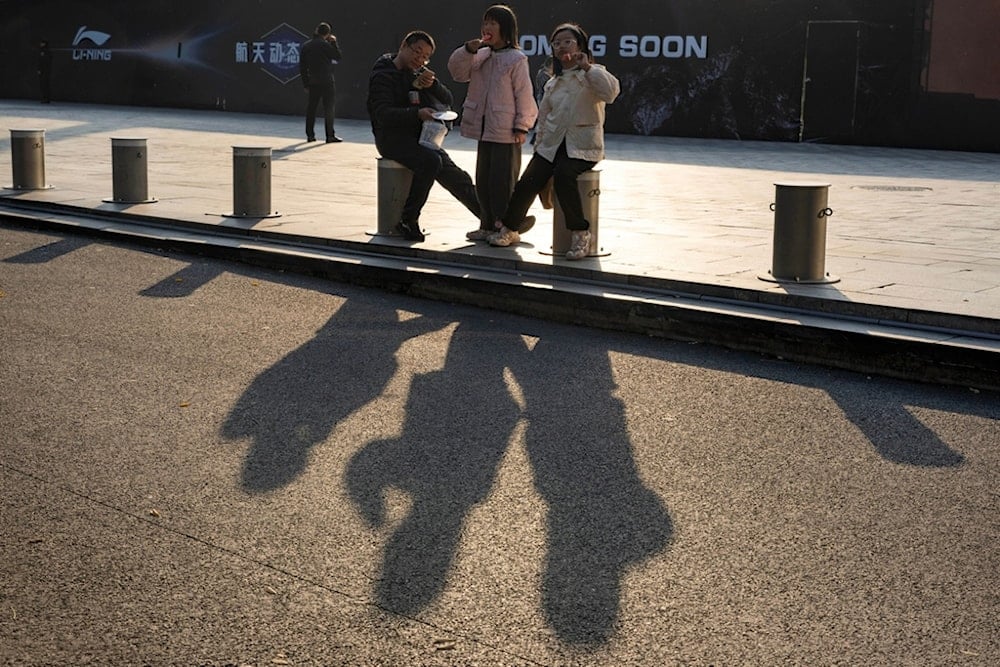China lifted millions as US let poverty surge to new highs: Analysis
China's state-led model eradicated extreme poverty while the United States, despite its immense wealth, continues to let inequality worsen through policy choices that neglect its poorest citizens.
-

Children eat snacks on the streets of Beijing, Tuesday, November 11, 2025. (AP Photo/Ng Han Guan)
Writing for The Guardian on Monday, NYT columnist and economist Eduardo Porter delivers a stark assessment of the United States’ worsening inequality, contrasting it with China’s dramatic decrease in extreme poverty over the past three decades. Porter notes that while Beijing succeeded in bringing the number of people living on less than $3 a day from 943 million in 1990 to zero by 2019, the US now counts more than 4 million citizens surviving on that same threshold, a figure that has tripled since the early 1990s.
Porter argues that the US narrative of relentless success obscures a deeper reality: the country’s extraordinary wealth has not translated into broad-based improvements for those living near poverty. Although the US remains among the world’s most productive economies, he writes that its prosperity has been undermined by choices "about how it deploys the fruits of its accomplishments and how it apportions the costs of its failures." Despite having per-capita output roughly six times China’s, the US "did not offer much to the people eking out a living around the poverty line," Porter observes, a fact he finds "inexplicable" given the country’s vast resources.
The contrast with China is not merely statistical but structural. China’s success in eradicating extreme poverty was not accidental: it is rooted in a state-driven development model that protected strategic sectors, directed surplus toward national priorities, and shielded its population from the destructive dynamics that have hollowed out social protections in many market-driven economies.
While Beijing used its growing economic power to expand public goods, upgrade domestic industries, and preserve control over essential resources, the United States steadily outsourced, financialized, and deregulated key sectors, leaving millions exposed to declining wages and upward redistribution.
Poverty engineered
The scale of US inequality, Porter shows, is staggering. The share of income earned by Americans in the middle has steadily eroded, falling from just over 52% of the income of those at the 90th percentile in 1980 to 42.5% in 2023. Meanwhile, the poorest 10% now take in just 1.8% of national income, roughly in line with some of the world’s most unequal developing economies. These outcomes reflect a political choice: a model that sacrifices the wellbeing of its most vulnerable to sustain profits at the top.
Porter rejects the comforting idea that such disparities are solely the result of market pressures. Globalization and technological change have played a role, he concedes, but they cannot explain why US leaders consistently adopt policies that deepen precarity among the working poor. China’s trajectory, meanwhile, demonstrates that a government unwilling to surrender control over its developmental path can insulate its people from the harshest effects of global market turbulence.
He points in particular to Donald Trump’s economic agenda, the "Big Beautiful Bill Act" and sweeping tariffs, which he says will push up consumer prices, curb investment, and ultimately "trim household income for all except the richest fifth of American families," according to Yale’s Budget Lab.
The poorest households, he notes, are projected to absorb a 7% hit. It is a continuation of a decades-long pattern in which successive administrations have allowed living standards at the bottom to erode while shielding those at the top from any meaningful sacrifice.
Democratic failure
While acknowledging that America’s "indifference towards its poor did not appear suddenly" and spans both major parties, Porter argues that Trump’s second-term agenda represents an especially sharp acceleration of choices that have drained the social state and concentrated wealth. Despite the president’s claim to champion "the common American worker," his proposals would strip health coverage from millions, slash food assistance, and funnel benefits disproportionately upward, a striking contrast with a country that managed to lift nearly a billion people from destitution through deliberate state planning.
Porter concludes that the comparison with China, hardly a celebration of its political system, should nevertheless force an uncomfortable reckoning: how is it that a country routinely presented as the world’s leading democracy has allowed extreme poverty to persist and even grow, while an avowedly non-Western, state-led model succeeded in eliminating it on a scale unprecedented in human history?
Read more: Oxfam warns: Inequality soars in US amid $698bln billionaire windfall

 4 Min Read
4 Min Read








